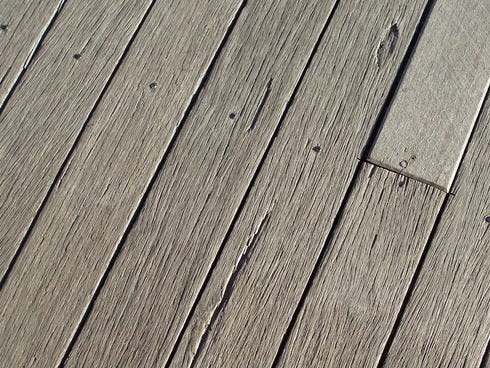
GAINESVILLE — Wet wood treated with the pesticide chromated copper arsenate (CCA) loses arsenic three times more than dry wood, so if it rains, you can expect more arsenic on your wood deck surface, a new University of Florida study shows.
That may pose a potential danger to anyone who plays or walks on the deck, and that most often means children or pets, said Julia “Ky” Gress, a doctoral student in soil and water sciences at the UF Institute of Food and Agricultural Sciences.
Gress led an experiment in which she and her colleagues used standard wipe methods to collect arsenic from the surface of wood from a 25-year-old South Florida deck. Although the CCA wood came from only one deck, it is representative of wood decks constructed before 2004, Gress said.
Before wiping the wood, researchers put water on it, then wiped it to see how much arsenic was present. They then cleaned different pieces of the decking with either tap water or a bleach-water solution, followed by pressure washing.
Results showed water alone caused three times more arsenic to form on the surface of wet wood than dry wood, and the use of bleach caused formation of chromate, another carcinogen. They also found that these chemicals remained on the wood surface for an hour after it was cleaned.
“The levels of arsenic and chromate coming off these boards are much higher than allowable levels and show the potential for soil and water contamination and public health impacts,” Gress said.
Her study, performed under the supervision of soil and water science Professor Lena Ma, is published in the current issue of the journal Environment International.
Wood treated with CCA was used on many residential decks built before 2004 because it is highly resistant to termites. But in 2003, the U.S. Environmental Protection Agency pressured industry to stop using CCA to treat wood intended for use around homes, including outdoor decks, after finding arsenic, a carcinogen, leaches out of wood.
Wood decks, picnic tables, fences and children’s playsets built before 2004 are likely constructed from CCA-treated wood, which can last for 20-40 years, Gress said.
In fact, about 10 years ago, the wood industry estimated half of single-family homes nationwide had a deck of porch made from CCA-treated wood. The results of this study show the importance of avoiding skin contact with wet decking, particularly right after cleaning with bleach, Gress said.
CCA wood continually leaches arsenic into the environment from normal rainfall and contaminates the soil around decks, Ma said. Because of this health hazard, the Consumer Product Safety Commission recommends that parents make sure children wash their hands after contact with the wood and avoid letting children or pets play in soil around CCA-wood decks.
This article originally appeared on Crestview News Bulletin: Institute of Food and Agricultural Sciences study cautions parents about arsenic from wet wood
